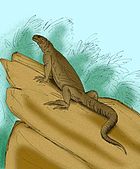Gobiguania
| Gobiguania Temporal range: Late Cretaceous,
| |
|---|---|
| Scientific classification | |
| Kingdom: | Animalia |
| Phylum: | Chordata |
| Class: | Reptilia |
| Order: | Squamata |
| Suborder: | Iguania |
| Clade: | Pleurodonta |
| Clade: | †Gobiguania Conrad and Norell, 2007 |
| Genera | |
|
†Anchaurosaurus | |
Gobiguania is an extinct clade of iguanian lizards from the Late Cretaceous. All known gobiguanians are endemic to the Gobi Desert of Mongolia. Gobiguania was given a phylogenetic definition by Jack Conrad and Mark Norell in 2007 as all taxa more closely related to Anchaurosaurus gilmorei than to Iguana iguana (the green iguana), Crotaphytus collaris (the common collared lizard), or Agama agama (the common agama). According to Conrad and Norell's phylogenetic analysis, Gobiguania includes Anchaurosaurus as well as several other Late Cretaceous lizards such as , Temujinia, Saichangurvel, and .[1] A phylogenetic analysis published in 2012 indicated that three other lizard genera — Igua, Isodontosaurus, and Polrussia, all from Mongolia and all from the Late Cretaceous — are also gobiguanians. Below is a cladogram from the analysis:[2]
| Iguania |
| ||||||||||||||||||||||||||||||||||||||||||||||||||||||||||||||||||||||||||||||||||||||||||||||||||||||||||||||||||||||||||||||||||||
References[]
- ^ Conrad, J. L.; Norell, M. A. (2007). "A Complete Late Cretaceous Iguanian (Squamata, Reptilia) from the Gobi and Identification of a New Iguanian Clade". American Museum Novitates. 3584: 1. doi:10.1206/0003-0082(2007)3584[1:ACLCIS]2.0.CO;2. hdl:2246/5877.
- ^ Daza, J. D.; Abdala, V.; Arias, J. S.; García-López, D.; Ortiz, P. (2012). "Cladistic Analysis of Iguania and a Fossil Lizard from the Late Pliocene of Northwestern Argentina". Journal of Herpetology. 46: 104–119. doi:10.1670/10-112. S2CID 85405843.
- Cretaceous lizards
- Late Cretaceous reptiles of Asia
- Fossils of Mongolia
- Gobi Desert
- Late Cretaceous first appearances
- Late Cretaceous extinctions
- Fossil taxa described in 2007
- Prehistoric lizard stubs
